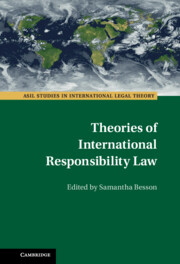Book contents
- Theories of International Responsibility Law
- ASIL Studies in International Legal Theory
- Theories of International Responsibility Law
- Copyright page
- Contents
- Contributors
- Preface
- Theorizing International Responsibility Law, an Introduction
- Part I International Responsibility of Public Institutions: Public and/or Private?
- Part II International Responsibility of Public Institutions: Collective and/or Individual?
- Part III International Responsibility of Public Institutions: Fault-based or Not?
- 9 Responsibility or Liability
- 10 Causation, Fault and Function in the Rules of Attribution
- 11 Time Travel in the Law of International Responsibility
- Part IV Responsibility of Public Institutions: A World Tour
- Index
11 - Time Travel in the Law of International Responsibility
from Part III - International Responsibility of Public Institutions: Fault-based or Not?
Published online by Cambridge University Press: 01 September 2022
- Theories of International Responsibility Law
- ASIL Studies in International Legal Theory
- Theories of International Responsibility Law
- Copyright page
- Contents
- Contributors
- Preface
- Theorizing International Responsibility Law, an Introduction
- Part I International Responsibility of Public Institutions: Public and/or Private?
- Part II International Responsibility of Public Institutions: Collective and/or Individual?
- Part III International Responsibility of Public Institutions: Fault-based or Not?
- 9 Responsibility or Liability
- 10 Causation, Fault and Function in the Rules of Attribution
- 11 Time Travel in the Law of International Responsibility
- Part IV Responsibility of Public Institutions: A World Tour
- Index
Summary
This chapter examines the temporality around which international law is articulated, with an emphasis on the doctrine of international responsibility. The chapter specifically elaborates on how the doctrine of international responsibility suspends international law’s one-directional temporality and provides discursive devices that allow one to travel back and forth between the past of wrongfulness and the present of responsibility. Such two-directional temporality, the chapter argues, is at the service of the narrative function of international responsibility in that such two-way time travel allows a re-representation of the real produced by legal claims made under the doctrine of international responsibility. The chapter ends with concluding remarks on the distinction between the imaginary and the real.
Keywords
- Type
- Chapter
- Information
- Theories of International Responsibility Law , pp. 252 - 276Publisher: Cambridge University PressPrint publication year: 2022
- 1
- Cited by

